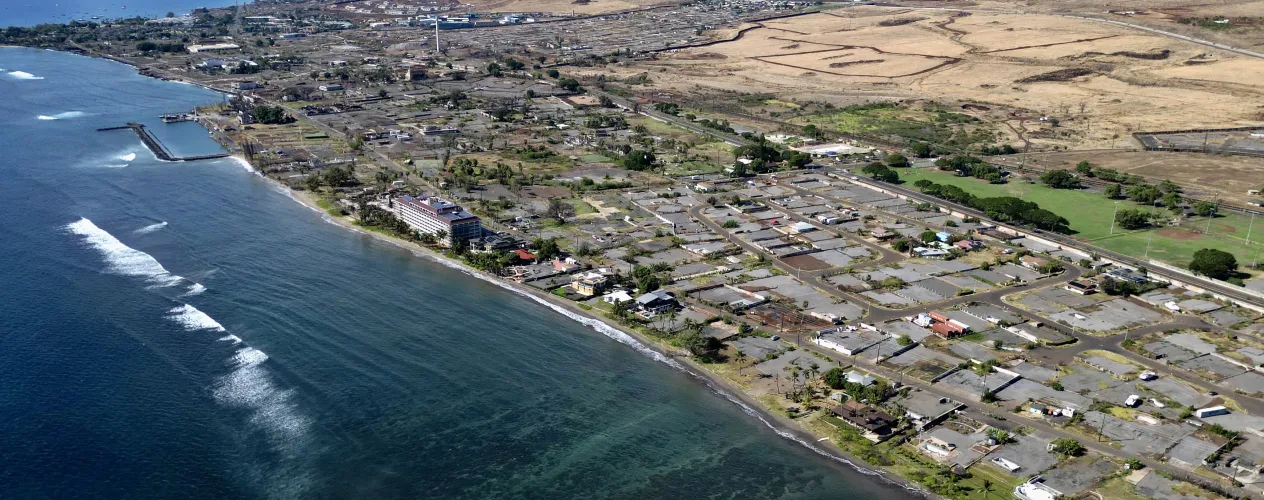Study of 2023 Hawaii fires co-led by UCLA researcher finds wildfires can raise local death rate by 67%
Dr. Kekoa Taparra, assistant professor in the UCLA Fielding Department of Health Policy and Management, co-authored study of Maui wildfires.

New research unveils the true death toll of the deadly August 2023 wildfires which took place in Hawaii — and which temporarily made wildfire a leading cause of death on the island of Maui.
The peer-reviewed study – “All-cause excess mortality associated with the Lahaina, Maui fires” – was published Aug. 22 in the Swiss-based research journal Frontiers in Climate, and was co-authored by Dr. Kekoa Taparra, a physician and assistant professor with the UCLA Fielding School of Public Health and the David Geffen School of Medicine at UCLA.
“Wildfires can cause death in a variety of ways,” said Taparra, the study’s co-first author. “In this case, recent reports suggest many deaths were due to direct exposure, smoke inhalation and burns. Others likely stemmed from disruptions in healthcare, like not being able to access critical medications or emergency treatment. Wildfires can also exacerbate pre-existing conditions.”
The researchers – including scholars with UCLA, New York University (NYU), Yale, and Harvard, among others - investigated the fatalities associated with severe wildfires in August 2023 in Lahaina, Maui, Hawaiʻi, and found that 82 more local people died that month than would have been expected — a 67% increase over the usual death rate. During the week of 19 August, deaths were 367% higher than normal. By comparing death rates over time, the analysts found that two-thirds more people died that August than would have been expected.
“Wildfires can cause a measurable, population-wide increase in mortality, beyond what is captured in official fatality counts,” said Michelle Nakatsuka of the NYU Grossman School of Medicine, co-first author of the study and member of the Taparra Lab at UCLA. “This suggests the true toll of the Lahaina wildfire was even broader than previously understood.
“It also points to the need for prevention strategies that go beyond reactive wildfire control,” Nakatsuka said. “As Native Hawaiians, Dr. Taparra and I are especially hopeful that wildfire mitigation strategies will center traditional perspectives, including the restoration of traditional farming and land management systems.”
To capture the wide range of possible deaths attributable to the fires, the authors calculated the all-cause excess death rate: this is how many more deaths took place over a given period than would have been expected. They trained a model on demographic data from Maui County – which includes the islands of Maui, Molokai, and Lanai - from August 2018 to July 2023, and weighted the analysis to exclude deaths caused by COVID-19.
The researchers found that in August 2023, 82 more deaths were reported than expected: an excess death rate of 67%. In the week of 19 August, the rate was 367% higher than expected, compared to previous years. Of those, 80% of the deaths did not take place in a medical context, 12% higher than in other months, suggesting some people never reached medical care because of the fires. At the same time, the proportion of deaths with a non-medical cause rose from 68% to 80%. This differs slightly from the official fatality count of more than 100, although it’s very close to the 88 fire-related deaths reported in August 2023 by the U.S. Centers for Disease Control and Prevention (CDC).
“We think this might reflect a temporary drop in other causes of death, like car accidents, during the fire period, similar to what we saw during COVID-19, when deaths from some non-COVID causes dropped during lockdowns,” Nakatsuka said. “It's also possible that some deaths occurred after the August time window we studied, for example from missed treatments or worsening of chronic conditions.”
The scientists point out that there are some limitations to this analysis. For instance, the data is not geographically granular enough to identify whether the death toll was particularly high in Lahaina, a town of roughly 13,000 population before the fires.
“Our study only covers a short time window, so we can’t speak to longer-term mortality impacts,” Nakatsuka said. “Excess mortality models also can’t determine exact causes of death, and we didn’t have access to detailed death certificate data like toxicology reports or autopsy findings. Still, we believe this type of analysis offers important insights into the broader health impacts of disasters like the Lahaina fire.”
To protect Hawaii from similar tragedies in the future, the researchers call for improved disaster preparedness and investment in the restoration of native plants and land management systems, which reduce the likelihood of destructive wildfires compared to modern monocultures and invasive plant species.
“In the long term, we’d like to see more policy investment in wildfire prevention rooted in Native Hawaiian ecological knowledge,” Taparra said. “This includes removing dry, non-native grasses, restoring traditional water systems, and improving fire risk modeling to better guide preparedness efforts.”
Methods
Excess mortality was estimated using seasonal autoregressive integrated moving average models trained on data from August 2018–July 2023. Projections were generated via 5,000 bootstrapped simulations, with a sensitivity analysis excluding COVID-19-attributed deaths.
Funding
No financial support was received for the research; UCLA supported its publication and dissemination.

